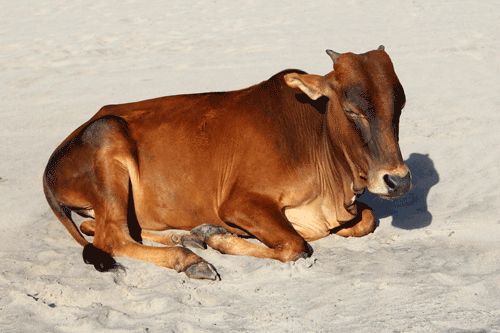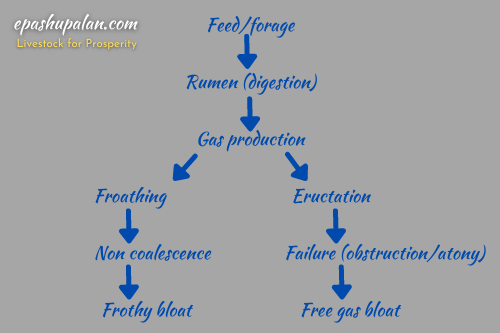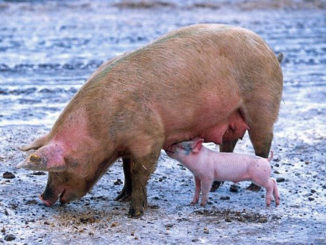Bloat
Abnormal distension of the rumen and reticulum caused by excessive retention of the gases of fermentation, either in the form of a persistent foam mixed with the rumen contents or as free gas separated from the ingesta.
Etiology
- Ingestion of bloating forages or
- Interference with eructation mechanism
Primary ruminal tympany (frothy bloat)
- Production of a stable foam that traps the normal gases of fermentation in the rumen.
- Coalescence of the small gas bubbles is inhibited and
- Intra ruminal pressure increases because eructation cannot occur.

Leguminous or pasture bloat
- Frothiness of the ruminal contents is the vital factor in pasture bloat
Feedlot bloat
- caused by feeding finely ground grain, which promotes frothiness of rumen contents; the cause is not clear
- susceptible to esophagitis, ruminal acidosis, rumenitis, overfill and ruminal atony each of which can interfere with eructation and cause secondary ruminal tympany and free-gas bloat.
Secondary ruminal tympany (free-gas bloat)
- Physical obstruction to eructation
- esophageal obstruction caused by
- A foreign body,
- Stenosis of the esophagus,
- Pressure from enlargements outside the esophagus, such as tuberculous , lymphadenitis or bovine viral leukosis ,involvement of bronchial lymph nodes, or obstruction of the cardia
- Interference with esophageal groove function
- vagus indigestion
- Diaphragmatic hernia – may cause chronic ruminal tympany (also occurs in tetanus, particularly in young animals)
- Carcinoma, granulomatous lesions – Actinomyces bovis near esophageal groove and in the reticular wall, and
- papillomata of the esophageal groove and reticulum
- Tetanus in cattle – secondary free gas bloat due to spasm of the esophagus and inability to eructate normally.
- Ruminal atony – anaphylaxis, sudden marked change in the pH of the rumen, hypocalcemia in milk fever
- Causes of the ruminal atony & failure of eructation esophagitis, acidosis, rumenitis and failure of rumination – all-grain diet
Pathogenesis

Clinical Finding
Primary pasture or feedlot bloat
- Quick distension of the rumen (as soon as 15 min)
- stand and lie down frequently,
- kick at its abdomen and even roll
- Frequent defecation and urination
- Dyspnea
- RR – increased upto 60/min
- Sudden death
Mild bloat
- Left PL fossa is distended, animal is not in distress, and 5-7 cm of skin over the left PL fossa may be easily grasped and ‘tented‘.
Moderate bloat
- More obvious distension is evident, animal may appear anxious and slightly uncomfortable, and the skin over the paralumbar fossa is usually taut but some can be grasped and tented.
Severe bloat
- prominent distension of both sides of the abdomen,
- the animal may breathe through its mouth and protrude the tongue.
- It is usually uncomfortable, anxious and may be staggering
- skin over the left flank is very tense and cannot be grasped and tented.
Secondary bloat
- ruminal distension, ruminal atony
- Dyspnea and tachycardia in severe bloat
- heart rate up to 100-120/min in the acute stages
- systolic murmur
Necropsy Finding
- Protrusion and congestion of the tongue,
- Marked congestion and hemorrhages of LNs to the head and neck, epicardium and upper respiratory tract,
- Friable kidneys and mucosal hyperemia in the small intestine.
- Lungs are compressed
- Congestion and hemorrhage of cervical portion of the esophagus but the thoracic portion of the esophagus is pale and blanched.
- Congestion is marked in the front quarters and less marked or absent in the hindquarters.
- Rumen is distended but the contents are much less frothy than before death.
- Marked erythema is evident beneath the ruminal mucosa, especially in the ventral sacs.
- Liver is pale because of expulsion of blood from the organ.
- Occasionally, rumen or diaphragm have ruptured.
- Exfoliation of the cornified epithelium of the rumen with marked congestion of submucosal tissues.
Treatment
- First-aid emergency measures
- Emergency rumenotomy
- Trocar and cannula
- Promote salivation
- Stomach tube
- Antifoaming agents :-
- Mineral oil 250 ml – 500ml
- Emulsified oil or with detergent DOSS
- synthetic surfactants – poloxalene 25-50 g
- Alcohol ethoxylates
Control
Management strategies to reduce rate of
- Rumen fermentation.
- Stage of growth
- Choice of forages
- Grazing management
- Antifoaming agents
- drenching
- spraying on pasture
- addition to feed and water
- Vegetable oils, mineral oil and emulsified tallow are effective
- Synthetic non-ionic surfactants – Poloxalene 2 g/100 kg BW.
- Alcohol ethoxylate detergents
- Ionophores- monensin
| The content of the articles are accurate and true to the best of the author’s knowledge. It is not meant to substitute for diagnosis, prognosis, treatment, prescription, or formal and individualized advice from a veterinary medical professional. Animals exhibiting signs and symptoms of distress should be seen by a veterinarian immediately. |






Be the first to comment